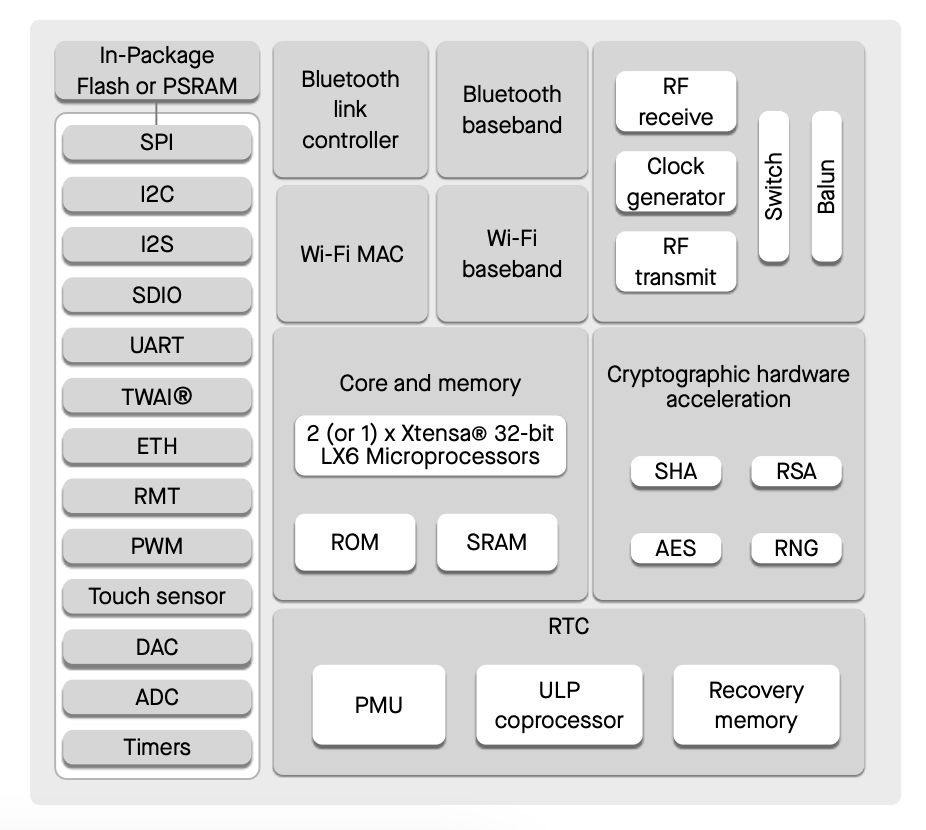Spesifikasi ESP32
dibuat untuk tugas mata kuliah EL5057 Sistem Penginderaan
Mari mengenal lebih detail ESP32 ini, dari namanya sih sepertinya singkatan dari nama perusahaan yang membungkus chipset ini kedalam satu chip yaitu ESPRESSIF. Espressif Systems adalah perusahaan semikonduktor yang berkantor pusat di Tiongkok, yang terkenal dengan pengembangan mikrokontroler, khususnya seri ESP8266 dan ESP32 yang sangat populer di komunitas elektronika dan Internet of Things (IoT). Didirikan pada tahun 2008, Espressif fokus pada inovasi dalam desain chip nirkabel dan sistem chip terintegrasi untuk aplikasi WiFi dan Bluetooth. Produk unggulan mereka, seperti ESP8266 dan ESP32, telah memainkan peran penting dalam mendorong pertumbuhan ekosistem IoT dan DIY (Do It Yourself).
Berdasarkan data dari laman resmi Espressif System tentang chipset ESP32 (https://esp32.net), berikut adalah blok fungsi (function block) lengkap dari ESP32 yang akan kita gunakan untuk belajar pemrograman mikrokontroler.
Nah, terlihat sangat lengkap sekali bukan, walaupun ukurannya sekecil kotak penghapus, ternyata kelengkapannya sangat mirip dengan personal computer yang kita punya. Berikut adalah fitur-fitur tambahan dari ESP32 yang sudah tertanam dalam SoC (System on Chip).
Wi-Fi
- 802.11b/g/n
- 802.11n (2.4 GHz), up to 150 Mbps
- WMM
- TX/RX A-MPDU, RX A-MSDU
- Immediate Block ACK
- Defragmentation
- Automatic Beacon monitoring (hardware TSF)
- 4 × virtual Wi-Fi interfaces
- Simultaneous support for Infrastructure Station, SoftAP, and Promiscuous modes Note that when ESP32 is in Station mode, performing a scan, the SoftAP channel will be changed.
- Antenna diversity
Bluetooth®Bluetooth®
- Compliant with Bluetooth v4.2 BR/EDR and Bluetooth LE specifications
- Class-1, class-2 and class-3 transmitter without external power amplifier
- Enhanced Power Control
- +9 dBm transmitting power
- NZIF receiver with –94 dBm Bluetooth LE sensitivity
- Adaptive Frequency Hopping (AFH)
- Standard HCI based on SDIO/SPI/UART
- High-speed UART HCI, up to 4 Mbps
- Bluetooth 4.2 BR/EDR and Bluetooth LE dual mode controller
- Synchronous Connection-Oriented/Extended (SCO/eSCO)
- CVSD and SBC for audio codec
- Bluetooth Piconet and Scatternet
- Multi-connections in Classic Bluetooth and Bluetooth LE
- Simultaneous advertising and scanning
CPU and Memory
- Xtensa® single-/dual-core 32-bit LX6 microprocessor(s)
- CoreMark® score:
- 1 core at 240 MHz: 504.85 CoreMark; 2.10 CoreMark/MHz
- 2 cores at 240 MHz: 994.26 CoreMark; 4.14 CoreMark/MHz
- 448 KB ROM
- 520 KB SRAM
- 16 KB SRAM in RTC
- QSPI supports multiple flash/SRAM chips
Clocks and Timers
- Internal 8 MHz oscillator with calibration
- Internal RC oscillator with calibration
- External 2 MHz ~ 60 MHz crystal oscillator (40 MHz only for Wi-Fi/Bluetooth functionality)
- External 32 kHz crystal oscillator for RTC with calibration
- Two timer groups, including 2 × 64-bit timers and 1 × main watchdog in each group
- One RTC timer
- RTC watchdog
Advanced Peripheral Interfaces
- 34 × programmable GPIOs
- 5 strapping GPIOs
- 6 input-only GPIOs
- 6 GPIOs needed for in-package flash/PSRAM (ESP32-D0WDR2-V3, ESP32-U4WDH)
- 12-bit SAR ADC up to 18 channels
- 2 × 8-bit DAC • 10 × touch sensors
- 4 × SPI
- 2 × I2S
- 2 × I2C
- 3 × UART
- 1 host (SD/eMMC/SDIO)
- 1 slave (SDIO/SPI)
- Ethernet MAC interface with dedicated DMA and IEEE 1588 support
- TWAI®, compatible with ISO 11898-1 (CAN Specification 2.0)
- RMT (TX/RX)
- Motor PWM
- LED PWM up to 16 channels

